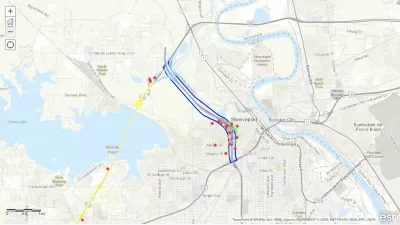Strong Towns is rolling out an in-depth analysis of a controversial proposal in Shreveport, Louisiana to build a new connector for Interstate 49 North in the heart of the city.

"For the past seven years, a David & Goliath struggle has taken place in Shreveport—Louisiana’s third largest city—over a proposal to build a 3.6 mile long innercity connector (ICC) for Interstate 49 North," writes Jennifer Hill.
Hill sets an examination of the proposal's planning and route alternatives amongst the political context of Shreveport. According to Hill, "both sides—those for its construction and those against it—see the I-49 ICC having long-term ramifications for Shreveport as a city."
The proposal is currently in limbo, as the Providence Engineering Group, hired to conduct in-depth studies of the proposal, has been unable to reduce five route alternatives down to two preferred options. According to a spokesperson, the company doesn't think the route would pass Federal Highway Administration (FHWA) regulations for compliance with the National Environmental Policy Act (NEPA). According to Hill's explanation, "[a]ll five routes had public structures or spaces, such as historical landmarks, parks and churches, which cannot legally be removed, harmed or destroyed in order to allow a federal highway to be built."
Hill goes on to examine the debate surrounding the I-49 ICC proposal in more detail, placing it context of the current thinking about downtown highways as a benefit or an obstacle to economic development.
Hill's article is part of a series of articles and coverage from Strong Towns on the subject of the I-49 ICC proposal.
FULL STORY: Shreveport's Highways at a Crossroads

Alabama: Trump Terminates Settlements for Black Communities Harmed By Raw Sewage
Trump deemed the landmark civil rights agreement “illegal DEI and environmental justice policy.”

Planetizen Federal Action Tracker
A weekly monitor of how Trump’s orders and actions are impacting planners and planning in America.

The 120 Year Old Tiny Home Villages That Sheltered San Francisco’s Earthquake Refugees
More than a century ago, San Francisco mobilized to house thousands of residents displaced by the 1906 earthquake. Could their strategy offer a model for the present?

Indy Neighborhood Group Builds Temporary Multi-Use Path
Community members, aided in part by funding from the city, repurposed a vehicle lane to create a protected bike and pedestrian path for the summer season.

Congestion Pricing Drops Holland Tunnel Delays by 65 Percent
New York City’s contentious tolling program has yielded improved traffic and roughly $100 million in revenue for the MTA.

In Both Crashes and Crime, Public Transportation is Far Safer than Driving
Contrary to popular assumptions, public transportation has far lower crash and crime rates than automobile travel. For safer communities, improve and encourage transit travel.
Urban Design for Planners 1: Software Tools
This six-course series explores essential urban design concepts using open source software and equips planners with the tools they need to participate fully in the urban design process.
Planning for Universal Design
Learn the tools for implementing Universal Design in planning regulations.
Clanton & Associates, Inc.
Jessamine County Fiscal Court
Institute for Housing and Urban Development Studies (IHS)
City of Grandview
Harvard GSD Executive Education
Toledo-Lucas County Plan Commissions
Salt Lake City
NYU Wagner Graduate School of Public Service





























